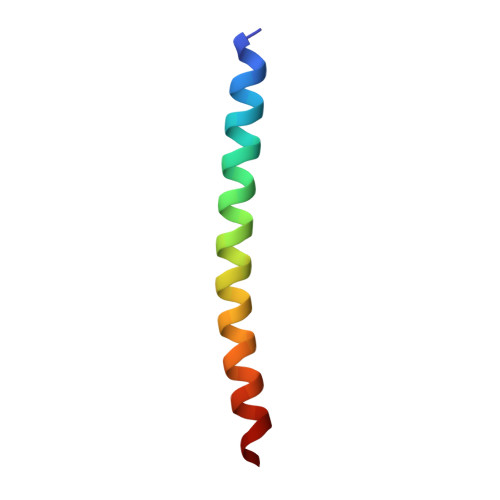Role of a putative gp41 dimerization domain in human immunodeficiency virus type 1 membrane fusion.
Liu, J., Deng, Y., Li, Q., Dey, A.K., Moore, J.P., Lu, M.(2010) J Virol 84: 201-209
- PubMed: 19846514
- DOI: https://doi.org/10.1128/JVI.01558-09
- Primary Citation of Related Structures:
3GWO, 3H00, 3H01 - PubMed Abstract:
The entry of human immunodeficiency virus type 1 (HIV-1) into a target cell entails a series of conformational changes in the gp41 transmembrane glycoprotein that mediates the fusion of the viral and target cell membranes. A trimer-of-hairpins structure formed by the association of two heptad repeat (HR) regions of the gp41 ectodomain has been implicated in a late step of the fusion pathway. Earlier native and intermediate states of the protein are postulated to mediate the antiviral activity of the fusion inhibitor enfuvirtide and of broadly neutralizing monoclonal antibodies (NAbs), but the details of these structures remain unknown. Here, we report the identification and crystal structure of a dimerization domain in the C-terminal ectodomain of gp41 (residues 630 to 683, or C54). Two C54 monomers associate to form an asymmetric, antiparallel coiled coil with two distinct C-terminal alpha-helical overhangs. This dimer structure is conferred largely by interactions within a central core that corresponds to the sequence of enfuvirtide. The mutagenic alteration of the dimer interface severely impairs the infectivity of Env-pseudotyped viruses. Moreover, the C54 structure binds tightly to both the 2F5 and 4E10 NAbs and likely represents a potential intermediate conformation of gp41. These results should enhance our understanding of the molecular basis of the gp41 fusogenic structural transitions and thereby guide rational, structure-based efforts to design new fusion inhibitors and vaccine candidates intended to induce broadly neutralizing antibodies.
- Weill Medical College of Cornell University, Department of Biochemistry , New York, NY 10021, USA.
Organizational Affiliation:
















